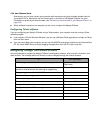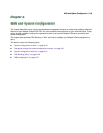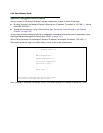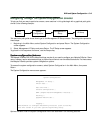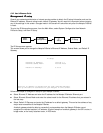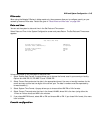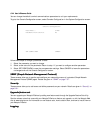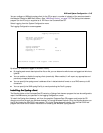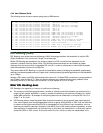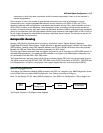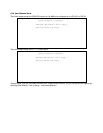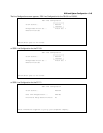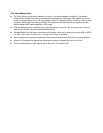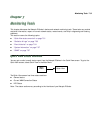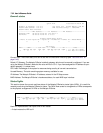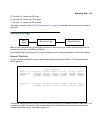
6-46 User’s Reference Guide
The following screen shows a sample syslog dump of WAN events:
DD
DD
SS
SS
LL
LL
BB
BB
oo
oo
nn
nn
dd
dd
ii
ii
nn
nn
gg
gg
((
((
ii
ii
MM
MM
uu
uu
xx
xx
))
))
DSL Bonding, also called inverse multiplexing or IMUX, technology combines the bandwidth of multiple DSL
(Digital Subscriber Line) circuits into a single virtual data pipe.
Before DSL Bonding was developed, the maximum speed of a DSL connection was dependent on the
customer's distance from the central office. DSL Bonding allows customers who are located at greater
distances from the central office to aggregate DSL circuits, in order to achieve two or more times the speed
otherwise available to them with a single line.
The premise behind DSL Bonding is to provide a cost-effective means of bridging the bandwidth gap between
relatively low network speeds and much higher rates, thereby allowing high-speed applications to use bandwidth
up to 3 Mbps.
Netopia's DSL routers and DSUs with bonding allow users with 1.5 Mbps SDSL connections to enjoy speeds of
over 3 Mbps, twice as fast as T1. They also allow customers who, because of line quality problems, were
previously limited to a 144 Kbps IDSL connection, to enjoy speeds of up to 576 Kbps.
WW
WW
hh
hh
aa
aa
tt
tt
DD
DD
SS
SS
LL
LL
BB
BB
oo
oo
nn
nn
dd
dd
ii
ii
nn
nn
gg
gg
dd
dd
oo
oo
ee
ee
ss
ss
DSL Bonding is the opposite, or inverse, of traditional multiplexing:
■ The concept of multiplexing applies when a number of relatively small data streams are combined into a
single line with greater bandwidth, in order to increase the efficiency and maximize utilization of a higher
speed WAN connection. An example of multiplexing would be the combination of multiple DS0 links in a
single T1 or E1 circuit.
■ DSL Bonding takes a single high-speed data stream and spreads it across several lower speed physical
links, which logically form a single aggregated channel or group. Multiple SDSL or IDSL lines are combined
to create a single logical data channel that is the aggregate of the individual lines’ bandwidths, minus a
small amount used for overhead. A packet of information from a LAN, video conferencing session, or other
data application is broken down into individual bits or cells which are transmitted in a round robin fashion
across two SDSL or IDSL circuits. At the other end of the link, the bits or cells are reassembled in the
6, 152, 173.166.107.100, 3/10/99, 9:55:03 AM, RFC1483: IP up, channel 2, gateway: 163.176.107.1
6, 152, 173.166.107.100, 3/10/99, 9:55:08 AM, RFC1483-2 rate set to 576 Kbps
6, 152, 173.166.107.100, 3/10/99, 9:55:09 AM, DML-4 up
6, 152, 173.166.107.100, 3/10/99, 9:55:10 AM, RFC1483-2 rate set to 432 Kbps
6, 152, 173.166.107.100, 3/10/99, 9:55:10 AM, RFC1483-2 rate set to 432 Kbps
6, 152, 173.166.107.100, 3/10/99, 9:55:13 AM, DML-3 up
6, 152, 173.166.107.100, 3/10/99, 9:55:13 AM, DML-1 up
6, 152, 173.166.107.100, 3/10/99, 9:55:13 AM, DML-2 up
6, 152, 173.166.107.100, 3/10/99, 9:55:14 AM, >>WAN: Data link activated at 144 Kbps
6, 152, 173.166.107.100, 3/10/99, 9:55:14 AM, >>WAN: Data link activated at 144 Kbps
6, 152, 173.166.107.100, 3/10/99, 9:55:14 AM, >>WAN: Data link activated at 144 Kbps
6, 152, 173.166.107.100, 3/10/99, 9:55:15 AM, RFC1483-2 rate set to 144 Kbps
6, 152, 173.166.107.100, 3/10/99, 9:55:17 AM, RFC1483: Channel 2 up
6, 152, 173.166.107.100, 3/10/99, 9:55:20 AM, >>WAN: Data link activated at 144 Kbps
6, 152, 173.166.107.100, 3/10/99, 9:55:23 AM, BRIDGE: Line is up in ATM-Funi mode
6, 152, 173.166.107.100, 3/10/99, 9:55:24 AM, --Device restarted----------------------------
6, 152, 173.166.107.100, 3/10/99, 9:55:36 AM, >>WAN: IDSL 1 activated at 1568 Kbps
6, 152, 173.166.107.100, 3/10/99, 9:55:37 AM, BRIDGE: Line is up in ATM-Funi mode



